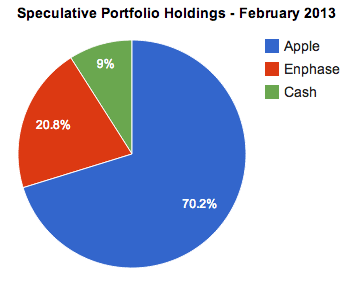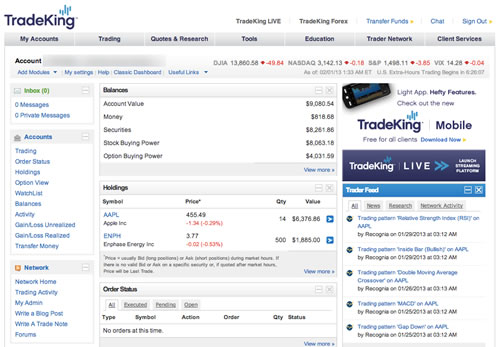Here’s the 2nd piece of the monthly updates for my Beat the Market Experiment, a set of three portfolios started on November 1st, 2012:
- $10,000 Passive Benchmark Portfolio that would serve as both a performance benchmark and an real-world, low-cost portfolio that would be easy to replicate and maintain for DIY investors.
- $10,000 Beat-the-Benchmark Speculative Portfolio that would simply represent the attempts of an “average guy” who is not a financial professional and gets his news from mainstream sources to get the best overall returns possible.
- $10,000 Consumer Loan Speculative Portfolio – Split evenly between LendingClub and Prosper, this portfolio is designed to test out the alternative investment of peer-to-peer loans. The goal is again to beat the benchmark by setting a target return of 8-10% net of defaults.
$10,000 Beat-the-Benchmark Speculative Portfolio as of February 1, 2013. Many people speculate with their money, buying and selling stocks now and then, but they rarely track their performance even though they may brag about their winners. Honest tracking is the primary reason for this “no-rules, just make money” account. I am using a TradeKing account for this portfolio as I’ve had an account with them for a while and am comfortable with their simple $4.95 trade structure and free tax-management gain/loss software. Here is a screenshot taken from my TradeKing home page after market close 1/31/13:
New activity. Well, this certainly wasn’t a great month for my stock picks. I basically tripled-down on Apple prior to their earnings announcement in late January, betting that they would have record-breaking profits in the 4th quarter. Well, they did, but the stock went down anyway due to growth concerns. I’m still giving it until the end of 2013 to see this play out, although I may pare back the position. I think Steve Jobs left us one last surprise… or I might just lose a bunch of money on this highly un-diversified move.
I also sold my Emerging Markets ETF (DEM) at a slight profit and used the proceeds to buy 500 shares of Enphase Energy (ENPH) at $3.77. Enphase manufactures micro-inverters for solar photovoltaic systems, which converts DC to AC and also allows you to individually track the power output of each panel on your roof. I believe that residential solar PV will take off soon, as electricity prices continue to rise and equipment costs drop. (Low interest financing won’t hurt either.) However, betting on a specific solar installer like SolarCity (SCTY) or a solar panel manufacturer when there is so much competition seems even harder. In addition, I believe that Enphase is a good takeover target in the future.
Here’s a pie chart of my holdings, tracked with a simple Google Docs spreadsheet (2nd tab):

Total value of stocks $8,261.86
Cash balance: $818.68
Total portfolio value (2/1/13): $9,080.54
2013 YTD return: -9.4%
Total return since inception (11/1/12): -$919, or -9.2%

 The Best Credit Card Bonus Offers – 2025
The Best Credit Card Bonus Offers – 2025 Big List of Free Stocks from Brokerage Apps
Big List of Free Stocks from Brokerage Apps Best Interest Rates on Cash - 2025
Best Interest Rates on Cash - 2025 Free Credit Scores x 3 + Free Credit Monitoring
Free Credit Scores x 3 + Free Credit Monitoring Best No Fee 0% APR Balance Transfer Offers
Best No Fee 0% APR Balance Transfer Offers Little-Known Cellular Data Plans That Can Save Big Money
Little-Known Cellular Data Plans That Can Save Big Money How To Haggle Your Cable or Direct TV Bill
How To Haggle Your Cable or Direct TV Bill Big List of Free Consumer Data Reports (Credit, Rent, Work)
Big List of Free Consumer Data Reports (Credit, Rent, Work)
Hmmm. You do realize that in the last eight years the U.S. has unlocked at least a 100-year supply of cheap natural gas residing in source rock under the ground, don’t you? Not so sure that bodes well for solar.
Too passive for me. If you want to beat market benchmarks, you have to pay attention to current events and trade accordingly – every day, every week, or at least set up limit orders, stop limits, etc. It takes work. Sticking money in higher risk investments and sitting on them hoping for good returns sounds a lot like gambling to me.
APPL has moved up nicely on Friday.
If you want to beat the market, I agree with Scott that you should be looking at stocks that are less tracked. Apple makes up a decent size of the S&P500 index. Perhaps you may want to take a look at NOK or BBRY, because they have a very high chance of beating the market.
Here’s an interesting idea, we can set up a challenge portfolio (I’ve done this in the past on my blog), where we compete to see who’s pick(s) gains the most % in a set period of time. 🙂
Stick with AAPL. Dont fall prey to Mr Market. If you do some valuation work on Apple youll find its really cheap. Why sell something that is cheap when you bought it more expensive? Makes no sense. If anything you put the rest of your cash in now. It goes against our psychology as humans but its how you make money in stocks. Or if you want to gamble some sell, take the cap gains loss and hope to buy at the same price or lower in 31 days.
Honestly I would spend a couple minutes doing some valuation work in Apple. Subtract the cash on the balance sheet and its trading a boring, value range PE. Look at the company your buying, not the price on the screen.